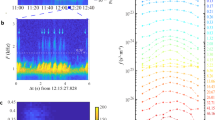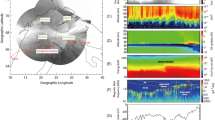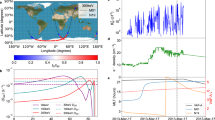Abstract
Earth’s diffuse aurora occurs over a broad latitude range1 and is primarily caused by the precipitation of low-energy (0.1–30-keV) electrons originating in the central plasma sheet2, which is the source region for hot electrons in the nightside outer magnetosphere. Although generally not visible, the diffuse auroral precipitation provides the main source of energy for the high-latitude nightside upper atmosphere3, leading to enhanced ionization and chemical changes. Previous theoretical studies have indicated that two distinct classes of magnetospheric plasma wave, electrostatic electron cyclotron harmonic waves4,5 and whistler-mode chorus waves6,7, could be responsible for the electron scattering that leads to diffuse auroral precipitation, but it has hitherto not been possible to determine which is the more important. Here we report an analysis of satellite wave data and Fokker–Planck diffusion calculations which reveals that scattering by chorus is the dominant cause of the most intense diffuse auroral precipitation. This resolves a long-standing controversy. Furthermore, scattering by chorus can remove most electrons as they drift around Earth’s magnetosphere, leading to the development of observed pancake distributions8, and can account for the global morphology of the diffuse aurora1,3.
This is a preview of subscription content, access via your institution
Access options
Subscribe to this journal
Receive 51 print issues and online access
$199.00 per year
only $3.90 per issue
Buy this article
- Purchase on Springer Link
- Instant access to full article PDF
Prices may be subject to local taxes which are calculated during checkout




Similar content being viewed by others
References
Petrinec, S. M., Chenette, D. L., Mobilia, J., Rinaldi, M. A. & Imhof, W. L. Statistical X-ray auroral emissions-PIXIE observations. Geophys. Res. Lett. 26, 1565–1568 (1999)
Eather, R. H. & Mende, S. B. Airborne observations of auroral precipitation patterns. J. Geophys. Res. 76, 1746–1755 (1971)
Newell, P. T., Sotirelis, T. & Wing, S. Diffuse, monoenergetic, and broadband aurora: the global precipitation budget. J. Geophys. Res. 114, A09207 (2009)
Lyons, L. R. Electron diffusion driven by magnetospheric electrostatic waves. J. Geophys. Res. 79, 575–580 (1974)
Horne, R. B. & Thorne, R. M. Electron pitch angle diffusion by electrostatic electron cyclotron harmonic waves: the origin of pancake distributions. J. Geophys. Res. 105, 5391–5402 (2000)
Villalon, E. & Burke, W. J. Pitch angle scattering of diffuse auroral electrons by whistler mode waves. J. Geophys. Res. 100, 19361–19369 (1995)
Ni, B., Thorne, R. M., Shprits, Y. Y. & Bortnik, J. Resonant scattering of plasma sheet electrons by whistler-mode chorus: contributions to diffuse auroral precipitation. Geophys. Res. Lett. 35, L11106 (2008)
Meredith, N. P. et al. “Pancake” electron distributions in the outer radiation belts. J. Geophys. Res. 104, 12431–12444 (1999)
Schulz, M. & Lanzerotti, L. J. Particle Diffusion in the Radiation Belts (Springer, 1974)
Lyons, L. R. Pitch angle and energy diffusion coefficients from resonant interactions with ion-cyclotron and whistler waves. J. Plasma Phys. 12, 417–432 (1974)
Horne, R. B. Path-integrated growth of electrostatic waves: the generation of terrestrial myriametric radiation. J. Geophys. Res. 94, 8895–8909 (1989)
Li W. et al. Evaluation of whistler-mode chorus intensification on the nightside during an injection event observed on the THEMIS spacecraft. J. Geophys. Res. 114, A00C14 (2009)
Li, W. et al. THEMIS analysis of observed electron distributions responsible for chorus excitation. J. Geophys. Res. 115, A00F11 (2010)
Li, W. et al. Global distribution of whistler-mode chorus observed on the THEMIS spacecraft. Geophys. Res. Lett. 36, L09104 (2009)
Meredith, N. P., Horne, R. B., Thorne, R. M. & Anderson, R. R. Survey of upper band chorus and ECH waves: implications for the diffuse aurora. J. Geophys. Res. 114, A07218 (2009)
Meredith, N. P., Horne, R. B., Thorne, R. M. & Anderson, R. R. Favored regions for chorus-driven electron acceleration to relativistic energies in the Earth’s outer radiation belt. Geophys. Res. Lett. 30, 1871 (2003)
Acknowledgements
This work was funded in part by NSF grant ATM 0802843 and by the UK Natural Environment Research Council. We thank R. R. Anderson for provision of the CRRES plasma wave data used in this study and S. Petrinec for reproduction of the PIXIE observations.
Author information
Authors and Affiliations
Contributions
R.M.T. and R.B.H. conceived the idea and oversaw the project development at UCLA and BAS, respectively. B.N. evaluated the diffusion rates on the basis of a statistical analysis of CRRES wave data by N.P.M. X.T. evaluated the temporal change in the electron distributions.
Corresponding author
Ethics declarations
Competing interests
The authors declare no competing financial interests.
Supplementary information
Supplementary Information
This file contains Supplementary Text comprising: Computation of chorus driven quasi-linear diffusion coefficients; Computation of ECH wave driven quasi-linear diffusion coefficients; Calculation of evolution of the electron phase space density. Also included are additional references and Supplementary Table 1. (PDF 295 kb)
Rights and permissions
About this article
Cite this article
Thorne, R., Ni, B., Tao, X. et al. Scattering by chorus waves as the dominant cause of diffuse auroral precipitation. Nature 467, 943–946 (2010). https://doi.org/10.1038/nature09467
Received:
Accepted:
Published:
Issue Date:
DOI: https://doi.org/10.1038/nature09467
This article is cited by
-
Whistler-mode chorus waves at Mars
Nature Communications (2023)
-
Diffuse auroral precipitation driven by lower-band chorus second harmonics
Nature Communications (2023)
-
Diffuse auroral intensities produced by whistler mode and electron cyclotron harmonic waves
Astrophysics and Space Science (2023)
-
The Electric and Magnetic Fields Instrument Suite and Integrated Science (EMFISIS): Science, Data, and Usage Best Practices
Space Science Reviews (2023)
-
Intense chorus waves are the cause of flux-limiting in the heart of the outer radiation belt
Scientific Reports (2022)
Comments
By submitting a comment you agree to abide by our Terms and Community Guidelines. If you find something abusive or that does not comply with our terms or guidelines please flag it as inappropriate.



